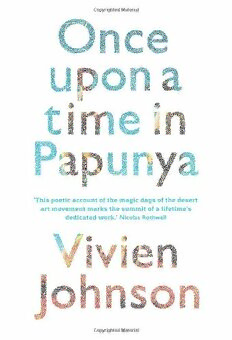
Once Upon a Time in Papunya PDF
Preview Once Upon a Time in Papunya
Once upon a time in Papunya ViVien Johnson has an extensive body of work relating to the artists of Papunya Tula and how the movement they started in 1971 has influenced the rest of the Western Desert and eventually all of Aboriginal Australia. Her pioneering books, including the monumental Lives of the Papunya Tula Artists, and her work on Indigenous cultural and intellectual property rights have had wide social impact. Her last appointment was as a Global Professor at the University of New South Wales. Vivien was also founding Editor-in-Chief of the Dictionary of Australian Artists Online. Once upon a time in Papunya Vivien Johnson A New South book Published by University of New South Wales Press Ltd University of New South Wales Sydney NSW 2052 AUSTRALIA www.unswpress.com.au Text © Vivien Johnson 2010 All paintings courtesy of the Aboriginal Artists Agency Ltd First published 2010 10 9 8 7 6 5 4 3 2 1 This book is copyright. Apart from any fair dealing for the purpose of private study; research; criticism or review; as permitted under the Copyright Act; no part may be reproduced by any process without written permission. Inquiries should be addressed to the publisher. National Library of Australia Cataloguing-in-Publication entry Author: Johnson, Vivien Title: Once upon a time in Papunya/by Vivien Johnson. ISBN: 978 174223 007 8 (pbk.) Subjects: Bardon, Geoff, 1940–2003 Papunya Tula Artists Pty. Ltd. Art, Aboriginal Australian. Aboriginal Australians – Northern Territory – Papunya – Painting. Painting, Aboriginal Australian – Northern Territory – Papunya. Painting, Aboriginal Australian – Northern Territory – Western Desert. Art, Australian – 20th century. Art and mythology. Dewey Number: 709.0110994291 Cover design Jenny Grigg Text design Jenny Grigg, Avril Makula and Di Quick Printer Ligare This book is printed on paper using fibre supplied from plantation or sustainably managed forests. All reasonable efforts were taken to obtain permission to use copyright material reproduced in this book, but in some cases copyright holders could not be traced. The author welcomes information in this regard. Contents Acknowledgments vi Introduction 1 1 The School of Kaapa 11 2 ‘So Beautiful’ 44 3 The Pintupi Factor 79 4 The Problem of Secrecy 100 5 The Midas Touch 139 6 The Object of Protection 187 7 Give Those Men a Real Voice 223 8 The Icons Precedent 266 Epilogue 295 Notes 297 Bibliography 325 Index 330 Acknowledgments Special thanks to my friends and colleagues John Kean, Jeremy Long and Fred Myers for reading some of the draft chapters and for their supportive and helpful comments; Sotheby’s Australia for their generous support in supplying images; all the artists of Papunya Tula, past and present; Alison Ander- son; Linda Anderson; Dorn Bardon; Geoffrey Bardon; Philip Batty; Roger Benjamin; Diana Calder; Wally Caruana; Fran- cesca Cavazzini; Jack Cooke; John Corker; Diane de Vere; Bob Edwards; Peter Fannin; Fred Friis; Christine Godden; Iris Harvey; Ian Howard; Mr and Mrs WL Jackson; Michael Jensen; Tim Johnson; Richard Kelton; Kate Khan; RG (Dick) Kimber; Tim Klingender; Graeme Marshall; Vincent Megaw; Michael Jagamara Nelson; Laurie Owens; Stephen Oxen- bury; Zena Pearlstone; Hetti Perkins; Charlotte Phillipus Napurrula; Long Jack Phillipus Tjakamarra; Cara Pinchbeck; Clifford Possum Tjapaltjarri; Arnold Probin; Richard Probin; Sarita Quinlivan; Alison Reid; Murphy Roberts Tjupurrula; Roxana Roman; Nicolas Rothwell; Judith Ryan; Luke Scho- les; Glenn Schwinghammer; Carmel and Rod Sears; Billy Stockman Tjapaltjarri; Paul Sweeney; Charlie Tjapangati; Turkey Tolson Tjupurrula; Grenville Turner; Penny Tweedie; Anthony Wallis; Ellen Waugh; Andy Weislogel; Bobby West Tjupurrula; Margie West; Simon Wheeler and The Ithaca Jour- nal; John and Barbara Wilkerson; Daphne Williams; Centre for Cross-Cultural Research, Australian National University; College of Fine Arts, University of New South Wales; the staff of Papunya Tula Artists Pty Ltd; Anna Lee my physio- therapist; and Museums and Art Galleries of the Northern Territory; Araluen Art Centre; Wollongong City Gallery; Art Gallery of New South Wales; National Gallery of Victoria; vi Once upon a time in Papunya Queensland Art Gallery; National Museum of Australia; Art Gallery of South Australia; Australian Museum; and the National Gallery of Australia. Every effort has been made to ensure the early Papunya boards reproduced in the book are all ‘unrestricted’ images and thus suitable for reproduction and distribution in Austra- lia or anywhere else. I am deeply grateful to the senior cultural authorities from Papunya, Kintore and Kiwirrkura, who inspected the images of early Papunya boards reproduced in this book and cleared them for possible publication. Acknowledgments vii Introduction Search for ‘Papunya, Northern Territory’ on Google Earth and you will see a huge circle, pierced on the right-hand side by the dirt road from Alice Springs 260 kilometres away to the south-east and on the left by another heading west 300 kilometres to Kintore, just inside the border with West- ern Australia. Inside this circle is the huddle of buildings comprising the remote Aboriginal community of Papunya. Only the Phillipus compound sits outside the circle, off to the north-west in the direction of Kalipinypa and other sites in the country of its patriarch, Long Jack Phillipus Tjakamarra, all but last of the founders of the famous Papunya Tula Artists company which started here almost forty years ago. If you look more closely, you can see four giant U-shaped tracks coming off the circle to the north, south, east and west. They’re hard to see because nothing has ever been built along them. After the torrential summer rains of 2009–10 in Central Australia, some of the heaviest since the incredible downpour of 1971–72, they have almost disappeared under a blanket of invasive buffel grass, at least from the air. On foot, though, they are still easy to find and follow. Every morning when I’m in Papunya, I take the one to the south, entering near the football oval, passing through a stand of mulga trees and emerging not far from the wide, sealed road to the airstrip, one of the most tangible achievements of the 1
